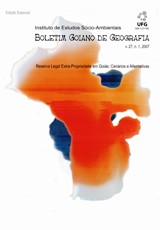BASE DE DADOS TERRITORIAIS NECESSÁRIAS À ANÁLISE DE UM SISTEMA DE RESERVA LEGAL EXTRA-PROPRIEDADE NO ESTADO DE GOIÁS - DOI 10.5216/bgg.v27i1.3441
DOI:
https://doi.org/10.5216/bgg.v27i1.3441Palavras-chave:
cerrado, bases de dados territoriais, análise sócio-econômicaResumo
O presente estudo teve por objetivo geral a compilação e caracterização das bases de dados utilizadas no âmbito do projeto “Cenários Econômicos para a Troca de Reserva Legal Extra-Propriedade no Estado de Goiás”. Mais especificamente, realizou-se uma análise de índices sócio-econômicos e de cobertura vegetal remanescente para uma malha hexagonal adotada pelo projeto, perfazendo todo o Estado. Dentre os resultados principais, destaca-se atual aspecto negativo da paisagem de Cerrado em Goiás, tanto em termos de Estado (45% da área original convertida em pastagens e 18% em agricultura), municípios (85% com passivos ambientais) e de mesoregião (Centro e Sul Goiano com menos de 20% de cobertura vegetal nativa). Quanto aos índices sociais (IDH, GINI, Pobreza e Densidade Populacional), fica demonstrado que o desenvolvimento em Goiás, ainda longe de ser sustentável em termos ambientais, é maior em áreas com atividades agrícolas intensas, como nas meso-regiões Sul e Centro Goiano, e menor ao Norte e Nordeste do estado, onde estão concentradas as maiores proporções de pobres, concentração de renda e, curiosamente, remanescentes de Cerrado. Este estudo indica a adoção de práticas econômicas para a manutenção/regeneração da biodiversidade do bioma Cerrado, complementar ao respeito das Áreas de Preservação Permanente, sobretudo àquelas com função ripária aos cursos hidrográficos.











